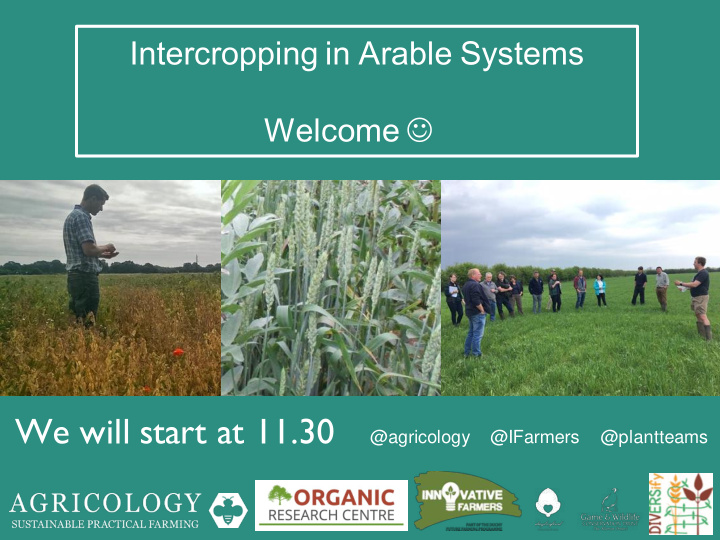



Intercropping in Arable Systems Welcome ☺ We will start at 11.30 @agricology @IFarmers @plantteams
Agenda 11.30: Katie Bliss - Intro and welcome 11.35: David Casebow - Farm tour: Including: Wheat legacy / Winter intercrop / Spring intercrop / Diverse forages / Diverse rotations Clarifying questions and comments 12.10: Insights from on farm trials in IF Field Lab Andy Howard , Bockhanger Farms Adrian Hares , Roundhill Farm 12.35: Others to give brief update on intercropping trials 12.45: Comments, questions and discussions
Intercropping in Arable Systems Field Lab • Share experiences • Collaborative research • On farm trials
What is intercropping? “The growing of two or more crop species where part or all of their crop cycle overlaps temporally and/or spatially, where one or more of the component species is taken to harvest” Andy Howard – Nuffield Report 2016 Facilitation, resource sharing and complementarity (Brooker et al, 2015)
• Virtual Farm tour https://www.uorcropsresearchunit.com/
Linseed and oats, Bockhanger Farm, Kent 18/19 Motivations: Oats to aid linseed establishment via reduction of pest pressure. Establishment: Linseed and oats drilled with cross slot in one pass on 27/03/19; • Linseed at 700 seeds/m2 / Oats at 0, 70 and 140 seeds/m2
Linseed and oats, Bockhanger Farm, Kent,18/19 Results • Higher average linseed yield in treatments with oats • Pest traps confirmed presence of flax flea beetle although in low abundance • 70 seeds/m2 seed rate had a slightly lower pest damage score (NS)
Linseed and oats 2019/20
OSR, Peas and oats, Bockhanger Farm, Kent 18/19 Motivations: a) Aid OSR establishment via reduction in pest pressure; b) OSR in supporting the pea crop and reducing lodging . Establishment: Marrowfat peas drilled at 70 seeds/m2 with and without OSRand an oat companion on 30/03/19. The treatments were: Monoculture peas; • Peas + OSR at 35 seeds/m2; • peas + OSR at 50 seeds/m2; • peas + OSR at 50 seeds/m2 plus oats at 70 seeds/m2. • These were replicated twice in strips across the field with monocrop replicated three times to assay in-field heterogeneity.
OSR, Peas and oats, Bockhanger Farm, Kent 18/19 Results • Average pest and disease damage T2 ‘ Peola ’ was higher in strips without oats (NS) • Two cabbage stem flea beetle pests were trapped across the entire trial • Poor establishment of the OSR • No detrimental effect on the pea in terms of nutrition or yields across treatments
Spring beans and oats, Bockhanger Farm, Kent (PGRO) 18/19 Results Bruchid infestation : Highest in low bean seed rates. Lowest in 45/45 • plants/m ² LER : All intercrop mixtures gave a LER >1.0. Highest LER was from the • mixture of Bean45/Oat70 (LER 1.30) Gross Output- variable cost: Highest in Bean45/Oat70 mixture •
DIVERSify trials, Bockhanger Farm, Kent 19/20
Peas and oats, Bockhanger Farm, Kent 19/20 Motivations: Trellis and weed suppression effects of oats Establishment:
ConyerPeas and Oats Plot 3: 70 plants/m2 Pea and 35 plants/m2 Oats
Lentils and oats, Bockhanger Farm, Kent 19/20 Motivations: Trellis and weed suppression effects of oats Establishment: Lentil Oat Plot 1 plants/m2 plants/m2 1 (0.14ha) 90 70 1b (0.14ha) 90 30 2 (0.2ha) 90 50 2b (0.2ha) 90 0 3 (0.25ha) 90 30 3b (0.25) 90 70 4 (0.34ha) 90 0 4b (0.34ha) 90 50
ConyerLentils and Oats Plot 3: 90 plants/m2 Lentils and 30 plants/m2 Oa
Plot Oats Bean 1 (0.87ha) 250 0 2 (0.88ha) 0 50 5 4 3 2 1 3 (0.88ha) 250 25 4 (0.87ha) 125 25 5 (0.87 ha) 80 15
Conyer Bean and Oats Plot 3 (RIGHT): 25 plants/m2 Beans and 250 plants/m2 Oats Plot 4 (LEFT) 25 plants/m2 Beans and 125 plants/m2 Oats
Plot Beans Oats 1 (0.50ha) Alternating 3m Alternating 3m 1 2 3 4 5 strips: Strips: 50 plants m2 250 plants m2 2 (0.52ha) Alternating 6m Alternating 6m strips: strips: 50 plants m2 50 plants m2 3 (0.54ha) Alternating Alternating Rows: 50 plants Rows: 70 plants m2 m2 4 (0.54ha) Alternating Alternating Rows: 50 plants Rows: 125 m2 plants m2 5(0.54ha) Mixed Rows Mixed Rows 50 50 plants m2 plants m2
Chilston Plot 2 Beans and Oats: Alternating 6m strips: 50 plants m2
Chilston Plot 4 Beans and Oats: Alternating rows: 50 plants m2
Plot Herbicide Undersown 1 (0.35 ha) No No 2 (0.35 ha) Yes No 5 4 3 2 1 3 (0.35 ha) Yes 2kg/ha Microclover 4 (0.35 ha) No 2kg/ha Microclover 5 (0.35 ha) No 4kg/ha Microclover
Cowhouse Plot 5: No herbicide and 4kg/ha microclover
Wheat and beans, Roundhill Farm, Wiltshire Motivations: Weed suppression (especially wild oat), increase wheat protein? Establishment: 1ha strips, wheat and beans in two passes 2018 Wheat Beans 174kg/ha 125kg/ha Tundra Beans Mulika 125kg/ha 2019 Wheat Beans 100kg/ha 200kg/ha Tundra Beans Mulika 200kg/ha Processing and use: Harvested together and used on farm as a mixed feed for livestock.
Wheat and beans, Roundhill Farm, Wiltshire Results: • 2018 – Weeds: 74% less dry weed biomass in intercrop than monocrop – Yield: Small bean yield penalty in intercrop (wheat rate too high?) • 2019 – Weeds : 73% less dry weed biomass in intercrop than monocrop – Yield: Monoculture crop destroyed due to high weed burden Some indication of improved wheat quality in intercrop in 2019 with protein content of 10.94 v 10.67 in monocrop.
DIVERSify @ James Hutton Institute
DIVERSify @ James Hutton Institute
DIVERSIFY • If Ali sends something...
REMIX @ Scotland's Rural College
In summary.... • No silver bullet – find what works on your farm • Set key objectives for mixture • Priority crop? Focus on yield of this crop • Try different seed rates / varieties on small area • Be clear about the end use and how to separate if needed • Speak to others who are doing it – join the Intercropping Field Lab!
Find out more….www.agricology.co.uk @ agricology and YouTube channel! ☺
Recommend
More recommend